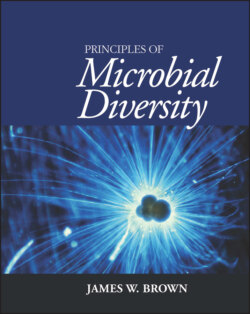Читать книгу Principles of Microbial Diversity - James W. Brown - Страница 34
Early phylogenetic trees
ОглавлениеBy the time of Charles Darwin, it was clear that the evolutionary ladder was not a reasonable view of evolution. Darwin describes a much better view, which has proven to be essentially correct, in which species originate by divergence, as shown in Fig. 2.3 (this diagram is the only illustration in On the Origin of Species).
It turns out that species actually evolve by diversification, not by progression. Eukaryotes did not evolve from bacteria, animals did not evolve from ciliates, plants did not evolve from fungi, and humans did not evolve from chimpanzees. Each of these pairs of modern organisms shares a common ancestor, from which each diverged. This is a fundamental aspect of evolution that is poorly understood even by many biologists.
Figure 2.2 The “evolutionary ladder,” an evolutionary transformation of the chain of being. (Redrawn from Prothero DR, Buell CD, Evolution: What the Fossils Say and Why It Matters. Copyright 2007 Columbia University Press. Reprinted with permission of the publisher.) doi:10.1128/9781555818517.ch2.f2.2
Figure 2.3 Evolution by diversification. In this diagram, species A and I at the beginning (bottom) split many times and diverge constantly. Most of these divergences do not go anywhere (they become extinct), but some do make it, at least for a while, resulting in this case in species A splitting into three separate surviving species and species I splitting into two surviving species at time X. Species A and I no longer exist at time X. Note that most of the original species (B through H, K, and L) are in stasis, remaining unchanged through the span of time shown here (or at least the part of it during which they survive). (Reprinted from Charles Darwin, On the Origin of Species. John Murray, London, 1859.) doi:10.1128/9781555818517.ch2.f2.3
One of the best developed of the early divergent evolutionary trees was that of Ernst Haeckel. In this tree, there are three major, equivalent divisions of life—plants, animals, and protists (Fig. 2.4). This tree is a huge improvement over the evolutionary ladder. It is a tree, species are not ranked, and modern species are not considered to be the ancestors of other modern organisms. Plants and animals are not thought of as having evolved from modern prokaryotes (monerans) but are separate groups.
The Whittaker five-kingdom tree being taught in various forms in most classrooms today is a refinement of this tree (Fig. 2.5). In some ways, however, this five-kingdom tree is actually a step backward toward the evolutionary ladder. In most versions of this scheme (such as the original tree by Whittaker, above), eukaryotes are shown to be descended from within the bacteria (not true), and in many representations eukaryotic algae are shown as descendants of cyanobacteria (not true), fungi are shown as descendants of filamentous gram-positive bacteria (not true), and protists are shown as descendants of wall-less gram-positive bacteria (also not true). Also notice the implied vertical axis: either superiority (sometimes expressed as “complexity”) or time (usually labeled “time of origin”). But if this axis is complexity, what exactly is being measured? Eukaryotes are sometimes morphologically complex, but what about parasites that have simplified; why are these organisms not drawn as downward-pointing arrows? What about metabolic complexity, which would place animals close to the bottom? Is morphological complexity the only factor being considered? Why? If the vertical axis is time of origin, why are the recent emergences of bacterial families, genera, and species not considered? The genus Escherichia emerged about 100 million years ago, about the same time as the primates; why is Escherichia (along with all other bacteria), a modern organism, shown as a relic of the past?
Figure 2.4 The tree of life. (Reprinted from Ernst Haeckel, Generelle Morphologie der Organismen. G. Reimer, Berlin, Germany, 1866.) doi:10.1128/9781555818517.ch2.f2.4
Figure 2.5 The five-kingdom tree taught in most schools in the United States. (Redrawn from Whittaker RH, Science 163:150–160, 1969. Used with permission from AAAS.) doi:10.1128/9781555818517.ch2.f2.5
The reality is that the five-kingdom tree is entirely qualitative and subjective.
